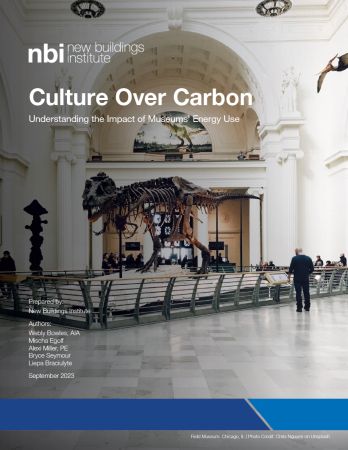ACTIONS
- Protect and safeguard cultural and natural heritage
- Learning and educational opportunities
- Cultural participation/social inclusion
- Sustainable tourism
- Support research
- Employment (recruiting, training, safety)
- Energy consumption, greenhouse gas emissions
- Waste management and reduction
- Transport (forms of, energy use)
- Commercial activities including copyright and IP
- Governance and management
- Security, disaster preparedness, risk reduction
- External partnerships and collaborations
- Publication/report
- Toolkit/framework/roadmap
- Case studies
Culture Over Carbon: understanding the impact of museums’ energy use
- W. Bowles, M. Egolf, A. Miller, B. Seymour and L. Braciulyte, New Buildings Institute
“Few cultural institutions have the ability or resources to monitor and assess their energy use, despite the increasing availability of tools and software and the many awareness-raising efforts by professional groups. The need to track this information is becoming critical as more building codes and policies are enacted that will require compliance from buildings in the cultural sector.
This project sought to conduct the [US museum] sector’s first in-depth review of the energy use patterns of cultural institutions and develop a roadmap for energy reduction at individual institutions and the sector.” (p.7)
Avaiable in
- English
SDGs LINKAGES
Implementing the resource helps address a range of SDG targets, including:
7.2 (increase the uptake of renewable energy), 7.3 (improve energy efficiency), 9.1 (develop sustainable infrastructure), 9.4 (upgrade existing infrastructure for sustainability), 11.6 (reduce the environmental impact of cities), 12.2 (sustainable use of natural resources), 12.6 (adopt sustainable practices and sustainability reporting), 12.8 (information for sustainable lifestyles in harmony with nature), 13.3 (climate education and action) and 17.17 (partnerships).
Click on the SDG Target to discover Our Collections Matter indicators
-
Our Collections Matter indicators:
- Proportion of energy that comes from renewable sources.
- Date to achieve net zero, and milestones towards that date.
-
Our Collections Matter indicators:
- Reduction in energy use.
- Upgrade of old equipment to more efficient equipment.
- Uptake of renewable sources of energy.
-
Our Collections Matter indicators:
- Development of research-useful collections to support reliable, sustainable and resilient use by researchers and others.
- Number and proportion of collections facilities and stores that support economic development and human well-being.
- Number and proportion of collections facilities and stores that provide affordable and equitable access for all.
- Investment in collections facilities.
- Inclusion of collections information in regional and transborder initiatives, notably via digital access for discoverability.
-
Our Collections Matter indicators:
- Number and proportion of collections facilities that make efficient use of resources, with an ongoing drive for efficiencies and reductions in energy use and waste of all forms.
- Number and proportion of collections facilities that use clean and environmentally sound technologies, including climate-friendly energy sources and materials, with an ongoing commitment to reduce greenhouse gas emissions and waste of all forms.
- Number and proportion of collections facilities that adopt and/or prioritise collections-related processes and practices to reduce greenhouse gas emissions and waste of all forms.
-
Our Collections Matter indicators:
- Plans in place to reduce negative impacts on air quality, and volume and forms of waste.
- Plans in place to eliminate waste of all forms as soon as possible.
-
Our Collections Matter indicators:
- Reduction of material footprint in terms of reductions in consumption of biomass, fossil fuels, metal ores and non-metal ores.
-
Our Collections Matter indicators:
- Clear visions, strategies and plans in place for all aspects of sustainability – environmental, social and economic (people, planet, prosperity)- across all areas of activity.
- Visions, strategies and plans relating to sustainability to be publicly available and incorporated into planning documents.
- Commitments to be in line with local, regional, national and/or international targets and ambitions.
- Incorporation of sustainability into reporting for funders and other stakeholders, including the public. Reporting to include commitments and progress towards targets.
-
Our Collections Matter indicators:
- Extent to which (i) global citizenship education and (ii) education for sustainable development (including climate change education) are mainstreamed in (a) national education policies; (b) curricula; (c) teacher education; and (d) student assessment.
- Extent to which global citizenship education and education for sustainable development (including climate change education) are mainstreamed in formal, informal and non-formal education programmes and activities drawing on and related to collections.
-
Our Collections Matter indicators:
- Plans in place to enhance positive contributions to addressing climate change through use of collections. Plans in place to ensure collections, collections institutions and broader society can adapt effectively to climate change.
- Plans in place for effective education and awareness raising on climate change mitigation, adaptation, impact reduction and early warning.
- Plans in place to reduce negative contributions of collections-related functions, e.g. measuring greenhouse emissions with plans and targets in place to reduce them.
-
Our Collections Matter indicators:
- Amount of United States dollars committed to public-private and civil society partnerships.
- Number and/or increase in number, and diversity of local, national and regional multi-stakeholder (public, public-private and civil society) partnerships that address the SDGs drawing on collections, or that otherwise involve collections-based organisations and institutions.

